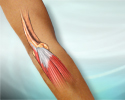Tennis elbow surgery - discharge
Lateral epicondylitis surgery - discharge; Lateral tendinosis surgery - discharge; Lateral tennis elbow surgery - discharge
You have had surgery for tennis elbow. The surgeon made a cut (incision) over the injured tendon, then removed (excised) the unhealthy part of your tendon and repaired it.
At home, be sure to follow your surgeon's instructions on how to take care of your elbow. Use the information below as a reminder.
What to Expect
Soon after surgery, severe pain will decrease, but you may have mild soreness for 3 to 6 months.
Symptom Relief
Place an ice pack on the dressing (bandage) over your wound (incision) 4 to 6 times a day for about 20 minutes each time. Ice helps keep swelling down. Wrap the ice pack in a clean towel or cloth. Do not place it directly on the dressing. Doing so, may cause frostbite.
Taking ibuprofen (Advil, Motrin) or other similar medicines may help. Ask your surgeon about using them.
Your surgeon may give you a prescription for pain medicines. Get it filled on your way home so you have it when you need it. Take the pain medicine when you start having pain. Waiting too long to take it allows the pain to get worse than it should.
Wound Care
The first week after surgery you may have a thick bandage or a splint. You should begin moving your arm gently, as recommended by your surgeon.
After the first week, your bandage, splint, and stitches will be removed.
Keep your bandage and your wound clean and dry. Your surgeon will tell you when it is OK to change your dressing. Also change your dressing if it gets dirty or wet.
You will likely need to see your surgeon in about one week.
Activity and Exercise
You should start stretching exercises after the splint is removed to increase flexibility and range of motion. You should move your elbow to avoid stiffness. The surgeon may also refer you to see a physical therapist to work on stretching and strengthening your forearm muscles. This can begin after 2 to 3 weeks. Keep doing the exercises for as long as you are told. This helps ensure tennis elbow will not return.
You may be prescribed a wrist brace. If so, wear it to avoid extending your wrist and pulling on the repaired elbow tendon.
Most people can return to normal activity and sports after 4 to 6 months. Check with your surgeon on the timeline for you.
When to Call the Doctor
After the operation, contact the surgeon if you notice any of the following around your elbow:
- Swelling
- Severe or increased pain
- Changes in skin color around or below your elbow
- Numbness or tingling in your fingers or hand
- Your hand or fingers look darker than normal or are cool to the touch
- Other worrying symptoms, such as increase in pain, redness, or drainage
References
Adams JE, Steinmann SP. Elbow tendinopathies and tendon ruptures. In: Wolfe SW, Pederson WC, Kozin SH, Cohen MS, eds. Green's Operative Hand Surgery. 8th ed. Philadelphia, PA: Elsevier; 2022:chap 25.
Cohen MS. Lateral epicondylitis: arthroscopic and open treatment. In: Lee DH, Neviaser RJ, eds. Operative Techniques: Shoulder and Elbow Surgery. 2nd ed. Philadelphia, PA: Elsevier; 2019:chap 54.
Review Date: 12/12/2022
Reviewed By: C. Benjamin Ma, MD, Professor, Chief, Sports Medicine and Shoulder Service, UCSF Department of Orthopaedic Surgery, San Francisco, CA. Also reviewed by David C. Dugdale, MD, Medical Director, Brenda Conaway, Editorial Director, and the A.D.A.M. Editorial team.


